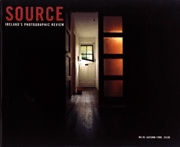The Popular Vote
Review by John Duncan
Issue 20 Autumn 1999
View Contents ▸
Photo Espana 99 was not organised with the specialist art press in mind. It was concerned with creating a festival for 'the people of Madrid'. The accompanying pocket-sized guidebook to this year's event identifies its broad aim as 'assisting in recovering emotion as the essential instrument of creation'. This was to provide a loose link across the work exhibited in over seventy venues. The well designed guide, complete with maps, in combination with highly visible signage throughout the city, made the physical negotiation of the exhibitions easy.
Traditional work was well represented with large exhibitions of work from André Kertész, Weegee and the work of the Photo League. Traditional Spanish documentary work was represented in the images of Ramon Masats who is credited with being a major influence on the photographers of his generation. His repertoire included street photography from the 50's, on Barcelona's major thoroughfare the Ramblas, and photo essays on the world of boxing. In his later years he seems to have shifted into producing some dubious coffee table books on bullfights.
The numerous commercial galleries in the city were only too happy to take part in the festival. Participation bought them publicity and a new audience. It also provided an opportunity for them to exhibit photographers already on their books. Much of the emphasis was on beautifully crafted prints in intricate frames with subject matter taking a back seat. The more prestigious galleries exhibited well know international names such as Thomas Ruff and Andreas Gursky. How much point there was in seeing one or two prints by these photographers seems debatable, but if you wanted to purchase a Thomas Joshua Cooper print, then what better opportunity.
The exhibitions were complemented by a wide range of talks and seminars by such luminaries as Andres Serrano and Martin Parr. There was also an opportunity for Spanish photographers to have their work discussed by picture editors and gallery people for a modest fee. The 'best' portfolio will be exhibited at next year's festival. Madrid's politicians had come out in force for the opening ceremony. Possibly as their first outing after European elections but seemingly eager to be associated with an up and coming festival date and make use of an opportunity to market Madrid as a cultural venue. With commitments by the politicians to finance the event it will be interesting to see how the festival grows. How will the popular vote be pleased next year?
Imago 99 Encuentros de Fotografia y Video is an event in its fourth year, run by the Centre for Photography at the University of Salamanca. The work presented a much more tightly focused series of exhibitions exploring different experiences of urban living. The core work by Thomas Demand, Susanne Brügger and Heidi Specker came from a show curated by Ute Eskildsen from The Folkwang Museum in Essen, Germany (she also co-curated  The Lie of the Land exhibition at the Gallery of Photography in Dublin). Thomas Demand's images present a series of tightly cropped interiors from the home and the work space. It is readily apparent that these are constructed sets from an advanced episode of the children's programme Blue Peter. It is a low-tech simulation: the edges of his constructed sets never quite meet. Heidi Specker's images are details of the exteriors of tower blocks. The unfocused images create a space that has been softened and where detail is missing. There is the feeling that we might just be looking at architectural models and not a real city. Susanne Brügger maps out a city through the use of aerial photographs. We move from an overview to details of specific city blocks complete with grid lines, scales and mapping co-ordinates. This pseudo-scientific mapping highlights our belief in, and reliance on, these systems as a way of understanding and quantifying our world.
The Lie of the Land exhibition at the Gallery of Photography in Dublin). Thomas Demand's images present a series of tightly cropped interiors from the home and the work space. It is readily apparent that these are constructed sets from an advanced episode of the children's programme Blue Peter. It is a low-tech simulation: the edges of his constructed sets never quite meet. Heidi Specker's images are details of the exteriors of tower blocks. The unfocused images create a space that has been softened and where detail is missing. There is the feeling that we might just be looking at architectural models and not a real city. Susanne Brügger maps out a city through the use of aerial photographs. We move from an overview to details of specific city blocks complete with grid lines, scales and mapping co-ordinates. This pseudo-scientific mapping highlights our belief in, and reliance on, these systems as a way of understanding and quantifying our world.
Imago was carefully put together, with each artist's individual vision connecting to the curatorial whole. There was sense of discovery in the dialogue and common ground between the work. If we increasingly understand our environment through its representation, then the work in Imago provided an interesting model for a way these representations may be considered.
Other articles by John Duncan:
Other articles mentioning John Duncan:






